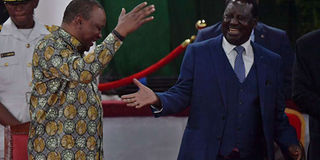To build strong bridges, first knock down old politics and ethnic walls

President Uhuru Kenyatta (left) and ODM leader Raila Odinga celebrate the launching of the BBI report at Bomas of Kenya, in Nairobi, on November 27, 2019. A fresh start should be entrusted to fresh leadership with fresh ideas. PHOTO | TONY KARUMBA | AFP
What you need to know:
- To argue that there was violence because there was an election is a blatant yet incompetent attempt to absolve the dominant political class of blame.
- We were back to the Rift Valley, and especially in Uasin Gishu, while previously we were in Olenguruone in Molo and Enoosupukia in Narok.
The term ethnic competition, when used in regard to political organisation and mobilisation, masks a crucial factor in Kenya's presidential polling and its aftermath.
Organisers and mobilisers resort to ethnicity as a weapon of attack or defence, or both, to be manipulated and milked for their numerical, psychological and electoral advantage.
In my view, then, the organiser and mobiliser are the culprits to be held responsible for corruption of the process, its toxicity and attendant negativity.
Responsibility and/or guilt thereof, cannot be ascribed to the ethnicities so targeted, but to the organisers and mobilisers who happen to be seekers of the presidency and/or their agents.
Second, I hold that these organisers and mobilisers, at whose hands Kenyans have lost limbs, lives, livelihoods and loved ones, should have no role in shaping the future Building Bridges Initiative envisages for Kenya.
HOTSPOTS
They have been so blatantly individualistic, divisive, selfish and stuck in the here-and-now and unmindful of tomorrow. Paul must be held responsible for Saul's infamy.
Last, I hold that while there is apprehension, tension and anxiety in Kenya come an election cycle, this should not be escalated, for political gain, to Kenya being engulfed in violence.
Kenya's elections have been peaceful, save for the following hotspots.
Scenario One: There was violence in Kenya in 1991 through 1992. There was no election in 1991 but there was in 1992.
The violence of 1991 was meant to send a clear message to certain Kenyan people resident in the Rift Valley about the following year's General Election.
It can be paraphrased thus: you are resident here, please respect we the local people and our politics and choice for President.
We oppose multiparty politics and will not stand any opposition to the governing party, Kanu.
GOVT'S FAILURE
And then all hell broke loose. The violence was instigated, organised and executed for the above political reasons.
And, more importantly, security agents must have known it was coming for they were forewarned.
But the government failed spectacularly to protect the citizens, their lives, loved ones, livelihoods and their property.
To argue that there was violence because there was an election is a blatant yet incompetent attempt to absolve the dominant political class — and the government it ran — of blame and lay it at the doorstep of the victims.
Victims because they fell into the trap to attack and victims because they were attacked.
This is a moral, political and legal abomination. Government would have nipped trouble in the bud or stopped the nascent violence in no time flat.
PREMEDITATED
Scenario Two: 1997. Suddenly, there was a daring raid on a police station in Likoni and guns and ammo were stolen and turned on the very people they were supposed to protect and on their livelihoods and property.
The violence was organised and it targeted the people regarded as outsiders (foreigners) and popularly called wabara (literally from up-country).
Wabara were profiled as anti-Kanu, anti-government people whose rapacity deprived locals of jobs.
Again the government, whose foremost duty is the security of its citizens, failed spectacularly to protect both wabara and locals.
Both wabara and locals were going about their lawful day to day activities when they were engulfed by politically instigated violence.
Scenario Three: There was political tension in the lead up to the General Election everybody thought would be held in 2012, as early as 2010.
Indeed, a certain Raila Odinga was Prime Minister and briefed editors on the need to lower the political temperatures.
ETHNIC MOBILISATION
Mr Odinga was under fire and under pressure. Dr William Ruto and Kalenjin political leaders were out to put as much distance as possible between he and their people before the next General Election.
The community, they argued, needed a homegrown kingpin. Remember the ethnic mobilisation that was centred around the crimes against humanity charges against Mr Uhuru Kenyatta and Dr Ruto?
Scenario Four: The infamous 41 against one mobilisation of the Orange Democratic Movement and the infamy of the country's worst election-induced violence of 2007.
And we were back to the Rift Valley, and especially in Uasin Gishu, while previously we were in Olenguruone in Molo and Enoosupukia in Narok.
The violent demonstrations of 2017 pale in comparison to the strife and unrest of 1991/92, 1997 and 2007, but the fear and despondency they spread after Mr Odinga's ‘swearing in’ as a rival president were widespread and business crippling.
A fresh start should be entrusted to fresh leadership with fresh ideas.





